Garden Designers Roundtable: Gardening with Nature, Gardening for Wildlife
Just in from a morning stroll through my garden, and what delights I witnessed. A tiny, blurry-winged hummingbird making the rounds from Mexican oregano to flame-leaf acanthus to Turk’s cap to Agastache. Honeybees spelunking for pollen. A leggy, spotted fawn tucked into a stand of bamboo muhly in the unfenced front garden, who bolted skittishly because I unknowingly stood too long near his hiding place.
Had I a typical expanse of flat, featureless lawn (like this example on Watersaver Lane at San Antonio Botanical Garden), relieved only by a few shade trees and a line of evergreen foundation shrubs, devoid of insect- and bird-attracting flowers and seeds, empty of plants that provide shelter, nurseries, and food for wildlife, I would not see many such visitors. Why would they visit a virtual desert, particularly if it were sprayed regularly with pesticides? And if they wouldn’t, why would we want to?
So how does one go about inviting wildlife into the garden from a design perspective?
1. Plant a variety of plants that change with the seasons, offering flowers for nectar or pollen, foliage for food or nests, and seeds for late-season food supplies. Using a very limited palette of plants may provide that clean, contemporary look you see in certain design magazines, but it won’t be as attractive to wildlife.
2. Add a mid-level of plants that fill the niche between lawn and shade trees. These plants provide shelter and food for wildlife. Think small trees; small to medium-sized shrubs, particularly those with fall or winter berries; ornamental grasses; and flowering perennials.
3. Don’t be in a hurry to “clean up” the garden in winter. Seedheads left standing provide food for birds, and even shriveled foliage and leaf litter offer protection for beneficial insects, lizards, etc.
4. Be tolerant when a plant gets “attacked” by caterpillars. Without caterpillars we wouldn’t have butterflies—or sphinx moths in this case.
5. Add water to your garden. Birds and insects get thirsty and need a safe place to drink. Provide a bird bath or small pond, and they will come.
6. Add nesting boxes to your garden. They not only offer birds a safe place to raise chicks but provide hours of enjoyment for you as you watch them get fed and learn to fly.
Visit all the participants in this month’s Garden Designers Roundtable for more posts about Gardening with Nature:
Debbie Roberts : A Garden of Possibilities : Stamford, CT
Douglas Owens-Pike : Energyscapes : Minneapolis, MN
Genevieve Schmidt : North Coast Gardening : Arcata, CA
Pam Penick : Digging : Austin, TX
Rebecca Sweet : Gossip In the Garden : Los Altos, CA
Scott Hokunson : Blue Heron Landscapes : Granby, CT
All material © 2006-2010 by Pam Penick for Digging. Unauthorized reproduction prohibited.


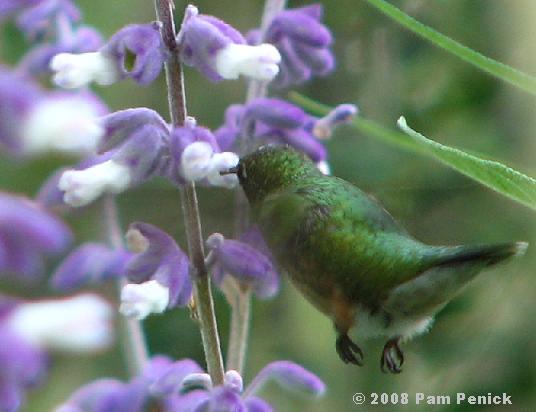
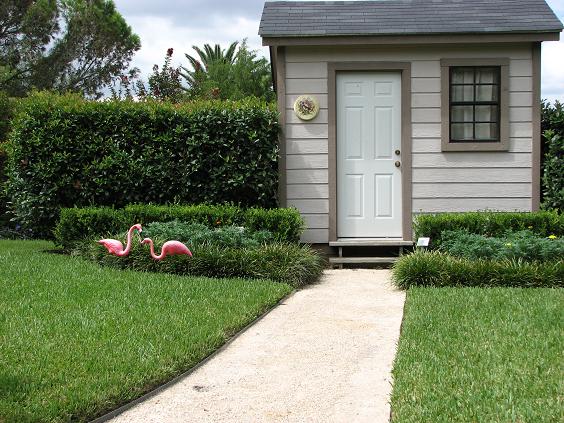
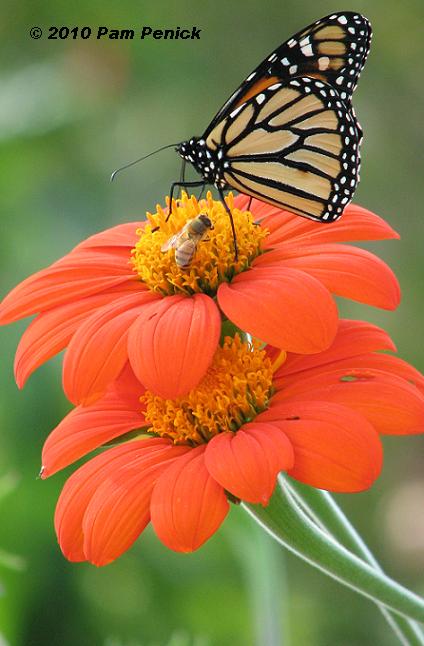
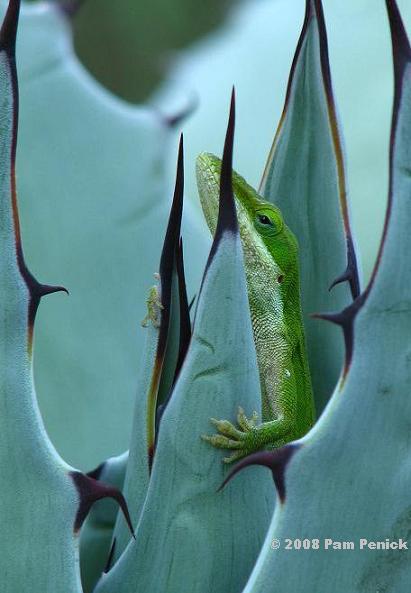
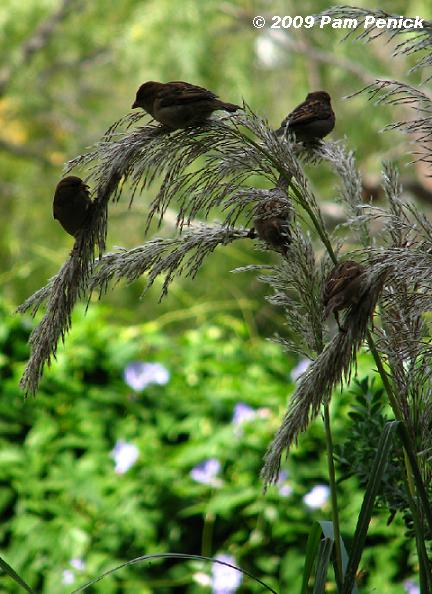
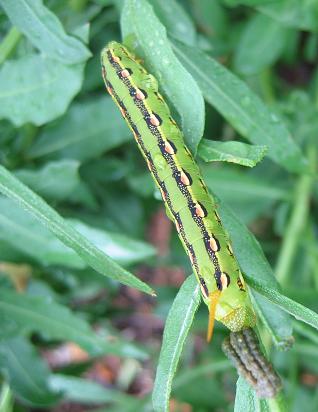
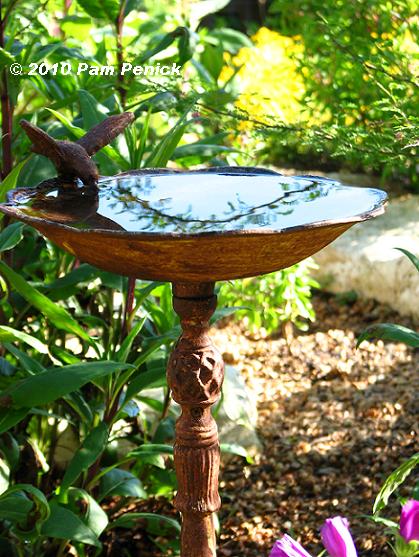
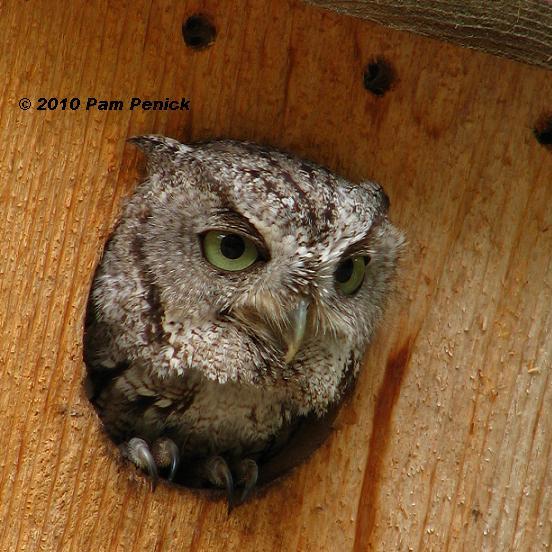
Excellent suggestions. The only one I have yet to follow is number 6 and as a Rice grad, I must remedy that this fall.
You must get an owl box, Cindy. All Rice grads should have one. —Pam
I think too many people like to get rid of wildlife, rather than enjoy it. My brother-in-law (who loves hunting) actually asked how to attract deers to his landscape, not how to get rid of them.
Guess that’s why they sell deer corn, right? —Pam
Your photos are to DIE for, Pam. Absolutely beautiful! Your photo from the Watersaver lane is brilliant as it completely demonstrates what a lifeless garden looks like!
Thank you, Rebecca! Watersaver Lane at SABG is so educational. In contrast to this sterile, typical American yard there are several beautiful alternatives designed to show people how to save water and attract wildlife. —Pam
hi pam, you’ve captured some nice creatures on your camera…! the anole clinging onto the agave is my favorite. no, the owl is my favorite. isn’t it nice to see these guys in the gardens you create? it’s one of the highest compliments one can get. well done!
Thanks, Andrea! Yes, seeing such creatures at home in the garden is very satisfying. —Pam
Pam, your photos are always so stunningly gorgeous, and provide ample inspiration to take your excellent advice!
I so want a nest-box for owls now. What a cutie!!
Thanks for the kind compliment, Genevieve. The owl box turned out to be such a gift to our whole family. We really enjoyed watching our owls. —Pam
Your pictures are wonderful – and should inspire any one to follow your suggestions!
Many thanks, Ginny. —Pam
Pam, Your photos speak for themselves. Who wouldn’t want to invite nature into their garden if they could get the chance to see some of the wildlife you’ve been able to capture in your own backyard. I love the hummingbird photo, I’m wondering how long it took you to snap that one!
Thank you, Debbie. I took the hummingbird photo in my former garden. I’d been stalking it for a few weeks, but whenever I tried to take its picture it would zoom away. That day it was occupied with the Mexican bush sage, and I just got lucky. —Pam
It is also important to have some idea of what might visit your garden if you provide the right food sources. A good book on your native flora and a good book on the fauna that frequent your area is a good place to start!
Good point, CIMS. Or asking local gardeners, right? I’m always surprised by the number of people who don’t know they have deer in their neighborhood. They don’t ever see them, but the evidence is there in the form of scat and other signs. —Pam
PS Those photos are super fantastic!!!!
Thanks! —Pam
Great suggestions and fantastic photos. I especially love the rear end photo of the hummer – not something one sees that often!
Thanks, Jean. Isn’t that a fun angle on that hummer? I got lucky with that shot. —Pam
Love the owl, Pam! Know where I can buy one?
You can probably buy an owl box, Grumpy, and that and patience is all you need to have an owl of your very own. We actually have a squirrel in ours right now, but I’m hoping another owl family will evict him next spring. —Pam
Your pictures really do say it all. I had forgotten how much I loved that one with the little lizard (?) and the agave.
Thanks, Loree. I miss those little anole lizards. They were all over my former garden, but in this part of town we seem to have the bigger, more reclusive Texas spiny lizards instead. Maybe I could import a few anoles to see if they’ll colonize the new garden. —Pam
I’ll take any of these living beauties over garden tchotchkes any day. This is a great elucidation of the principles of gardening for wildlife. I have to admit I started out completely ignorant of these principles. I just naturally liked the same plants animals and insects do!
Good point, Denise. People often start a garden with things that wildlife enjoy too: flowers and water features. Then they want more! —Pam
Well, I’ll cast my vote for the photo of the little birds (sparrows) on the grass! A beautiful, back lit composition that has a very Asian feel, to me. And oh yeah, good advice, too! I think it’s time for a nesting box in my garden…
Thanks, Jocelyn. Nesting boxes are so fun. If I lived where you do, I’d put out a mountain bluebird box. Is your garden ever visited by those beautiful birds? —Pam
Such wise advice especially about the cover that is needed and the range of plant material. Beautiful photography!
Thanks
Best
R
Thanks so much, Robert! —Pam
I totally agree!
Your garden shows how beautiful a wildlife-attracting garden can be, Cameron. —Pam
Great post, and pictures, as always. I was surprised at the fawn in your front shrubbery–you live IN TOWN. The fawn surprised you too.
What were the birds on the grass seedheads? Shape of goldfinches but too black.
Yes, even in town we have deer. Basically any neighborhood west of MoPac is deer territory, with some exceptions. In my neighborhood they live in the greenbelts along Hwy 360, and they spend considerable time browsing and resting in our front yards. I watch them passing behind my back fence, which backs up to a narrow greenbelt, every evening.
I thought the birds on the seedheads were common sparrows. But perhaps I’m mistaken? —Pam
Great post and LOVE the closeup photo of the Agave and lizard. I never thought of my Agaves providing cover for wildlife, but there you go!
Even agaves, spiky as they are, can be home-sweet-home to certain animals. This little anole lived in my Agave ovatifolia in my former garden. He was almost always there. —Pam
I thought I settled on the humming bird as my favorite photo but then looked again and am at a loss to make a choice! The anole is adorable! Great post and pictures. My garden has become so much more enjoyable for my family and friends since I started thinking more about the wildlife that visits than my own aesthetics.
Thank you, Cat! I’m glad you enjoyed the pics. As you point out, gardening for wildlife increases the pleasure of gardening in general. —Pam
Great advice Pam. You have my favorite photo here. The little lizard in the agave. Love it. Of course all the photos are marvelous.
I remember how you liked that anole and agave picture. Thanks again, Lisa. —Pam
The enjoyment of the plants and accessories in our gardens is multiplied ten-fold by the addition of wildlife we are so lucky to watch. Love your photos – especially that little owl and the lizard. I stopped killing tomato hornworms this year and simply relocated them to the woods.
Hornworms turn into sphinx moths, don’t they? I really love those big, hummingbird-like moths. —Pam
Hummingbirds and owls, two of my favorites! And I love the lizard photo. Thanks for sharing them.
My pleasure, Anna. Thanks for the kind words. —Pam
If one didn’t do what you suggested, how would one ever see something as wonderful as an agave-hugging lizard?
He’s pretty cool, isn’t he? Thanks for your comment, Les. —Pam
Great suggestions and wonderful photos. I got to enjoy watching hummingbirds in my garden today, but I certainly didn’t get such an awesome photos as the one accompanying your post!
Thanks for your comment, Jayne. I took this hummer photo a couple of years ago after stalking him for a few weeks. —Pam
Pam, I just love your photos! I had to stop and read a second time through because I kept jumping ahead to see the next one. You are an awesome, awesome photographer.
I’m blushing! Thanks for your very kind compliment, Leslie. I’m so glad you enjoyed the pics. —Pam
Oh believe me, I have so much going on in my gardens I never know what critters I will see. Excellent post.
Way to go on attracting wildlife to your own garden, Darla. It’s a great pleasure to see what comes to visit, isn’t it? Well, most of the time anyway. 😉 —Pam
Wise words, Pam! I gave a presentation on gardening with wildlife this weekend, and it was well received, except maybe when I mentioned cutting back on the monocultures known as lawn…:-)
Love the little green lizard (anole?) in the succulent. I found a yellow spotted salamander last night and was absurdly delighted by him. We have lots of them around, but I’m always pleased to find one.
Yes, that’s an anole lizard in the agave, Jodi. I never see salamanders here, but probably my garden is too dry. —Pam
Beautiful photos Pam, really spectacular captures! Then you add the excellent advice. A perfect post! gail
Thank you, Gail! —Pam
As always Pam, your pictures are amazing! I love the anole on the Agave, and am inspired to build a owl nest box by your picture. Great post!
Thanks, Scott. You’d so enjoy having an owl family. I’m hoping we get a repeat tenant next spring. —Pam
Excellent post Pam! Love the images, as always…but really love the message! Spot On girlfriend!
Thanks, Cheryl. I’m not surprised this topic resonated with you. You always demonstrate a love of wild nature on your blog. —Pam
What a beautiful blog! It’s my first visit and I’m sure I’ll be coming back for more.
Thanks for stopping by, Rebecca! —Pam
Great post Pam. You make a good point about the caterpillars. I planted a Scrophularia (aka Bee Plant) this year, thinking I would attract some native pollinators. It’s also a host plant for checkerspot butterfly larvae. The checkerspots found it…and devoured the plant down to an inch above the soil line! What I realized was, next year, one Scrophularia will not be enough! 🙂
Sometimes that’s indeed the case. You have to plant a bunch so that you can enjoy at least one. But think how happy you’ll make the caterpillars/butterflies. —Pam
You know, Pam, more and more gardeners seem to be seeing and agreeing that natural, wildlife, native & wildflowers, etc. is the way to go when it comes to gardening–and that is such a wonderful thing! I know I started out with birds, butterflies, bees & other wildlife in mind, and have always wanted to attract them–but that’s not the case for everyone (sadly!). But, it does seem that more people are coming to understand the importance of inviting critters into the garden…not just for the circle of life to function as it was meant to, but also for pure pleasure and enjoyment! Wonderful photos…you have the right touch with the camera!
Thanks, Jan. You are right that there is a lot of pleasure to be had in watching wildlife in the garden, and it’s so easy to attract them. All you have to do is relax your grip on things. —Pam
I was at work when I left a comment here yesterday. I wonder if it got blocked somehow, because I work at a school. Don’t remember what I said now, but I enjoyed the post. I do remember saying I like your birdbath. One of my tags is called, “Wildlife in the Corner Garden”. I have been thinking about balances lately. I enjoy seeing a variety of critters, but at times feel like they take more than whatever I think their share is out there.
I hope you are enjoying the weekend. I’m waiting for the sun to come up so I can go out to do some gardening before church this morning.
So sorry about your earlier comment getting lost, Sue! I hate it when that happens. Thanks for taking the trouble to come back and try again.
That birdbath you admired is in my mother-in-law’s garden, which I posted about last spring. It’s completely designed to attract wildlife—except for diamondback rattlesnakes, which they are trying to keep out, understandably. —Pam